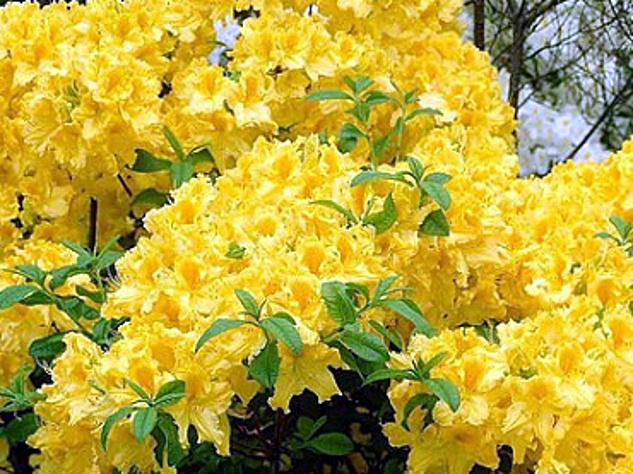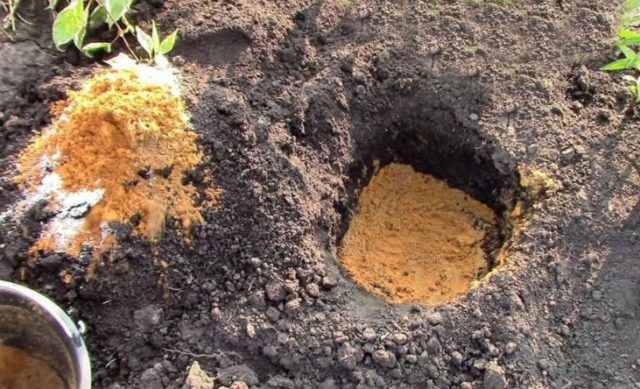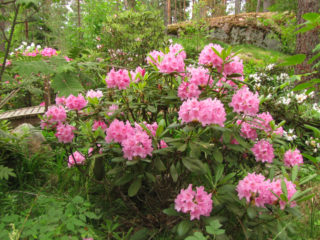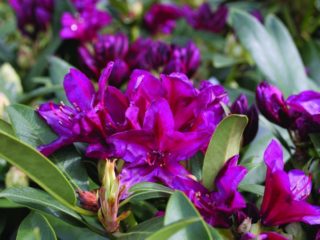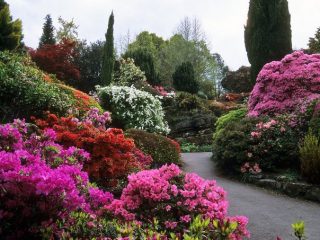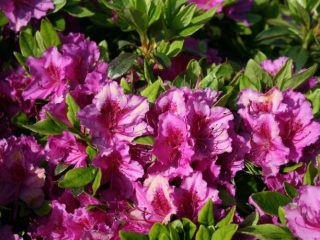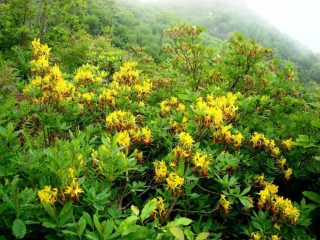Content
Anneke rhododendron belongs to the Knapp Hill-Exbury hybrid group, which is one of the most frost-resistant, which is especially suitable for growing crops in the Russian climate. The Anneke rhododendron is a yellow perennial, deciduous shrub. The plant is used in the design of garden plots, it is decorative throughout the warm season.
Description of Rhododendron Anneke
The Anneke rhododendron forms a slender, compact bush. Branch growth is vertical, growth rate is good. An adult plant over 10 years old reaches a height of 1.2 m, a width of 1.5 m. Leaves are elliptical, glossy. Green in summer, yellow in autumn.
Flowering begins from the second year of cultivation. Anneke's rhododendron begins to bloom together with the blooming of the leaves, from the end of April to the first decade of June.
A photo of Anneke's rhododendron shows that the plant forms monophonic flowers, bell-shaped, lemon-yellow in color, 6-8 cm in diameter. Stamens are yellow, long, with a bend. The petals are folded back with slight twisting. 7-10 flowers are formed in the inflorescence. Abundant flowering.
Winter hardiness of Anneke rhododendron
Anneke's yellow deciduous rhododendron tolerates winters well. Refers to the zone of frost resistance - 5. Withstands freezing without shelter up to -30 ° C.
Planting and caring for Anneke rhododendron
Anneke rhododendron grows well both in sunny areas and in the shade. It is most favorable to plant it in groups of 3 or more bushes. Ornamental shrubs are planted near walls, in open areas of lawns and near water bodies.
To grow rhododendron, Anneke needs an acidic substrate, which is used for planting and mulching the soil.
In joint plantings, hosts and ferns are used. An ornamental shrub is not planted next to trees that have a wide and dense root system, such as large spruces, lilacs and bird cherry trees.
A deciduous rhododendron is planted in a location where the soil around the shrub will not be trampled. Also, for a culture with a superficial root system, loosening and digging of the soil around the bush is not used.
Selection and preparation of the landing site
A deciduous shrub that can grow in one place for 30 years. Therefore, you should consider in advance a place for permanent cultivation, given the growth of the bush. Also take into account the proximity of cultures. The distance between shrubs and trees is kept at least 70 cm.
Plants are demanding on the composition of the soil. To grow an ornamental shrub, an acidic reaction of the soil is required - pH 4-5.5. To do this, in areas with a different type of soil, they dig holes or sites and completely replace the soil with a suitable one.
Seedling preparation
Seedlings with a closed root system, growing in containers before planting, can be planted at any time during the warm season. When removing a seedling from a container, it is necessary to inspect its root system.When growing in a container, the roots of the plant, which have been in contact with the walls for a long time, die off.
It will be difficult for young roots inside the coma to break through the formed felt layer. In the open field, such a plant will not develop and will die. Therefore, the felt layer of dead roots is removed completely or cut in several places.
Landing rules
For planting the rhododendron, Anneke is preparing a planting pit, the size of which is several times larger than the earthen lump of the seedling. The soil removed from the planting pit is mixed in equal parts with coniferous litter, which includes bark, needles, small branches of coniferous trees. Also, red high-moor peat is used for the substrate.
For loosening, sand is added to the soil mixture, a complex mineral composition is used as fertilizer. The prepared components are mixed. Drainage is poured at the bottom of the pit to a height of 20 cm. The acidic substrate is poured up to half of the planting pit or in quantity, depending on the size of the seedling.
The seedling is lowered vertically into the planting hole. The main rule when planting is not to deepen the root collar of the plant, leaving it above the ground at a height of 2 cm. The planting is covered with the remaining mixed substrate, pressed so that no voids remain between the root system and the soil. After planting, the plant is watered abundantly.
Pine bark is used for mulching, adding it several times per season. When growing ornamental shrubs, manure, black soil or low-lying peat are not used.
Watering and feeding
The soil under the Anneke rhododendron is always kept moderately moist. The bush is watered with heated rainwater, once a month an acidifier is added to the water for irrigation. In dry weather, the crown is sprayed.
For active flowering, the shrub needs top dressing. For this, liquid fertilizers are used, for rhododendrons or flowering plants.
Pruning
Anneke's deciduous rhododendron lends itself well to pruning and shaping. But due to the small annual growth rate, only sanitary pruning is most often used during cultivation. Only old or broken shoots are removed.
Preparing for winter
Anneke's rhododendron is frost-resistant. But in severe frosts, it must be protected with a dry shelter. Due to the early flowering, the hybrid is more suitable for the southern growing regions.
Reproduction of deciduous rhododendron Anneke
Anneke hybrid rhododendron is propagated in a vegetative way: by cuttings and layering. Cuttings of early flowering shrubs are cut in late spring. Planting material is taken from the tops of healthy bushes and from semi-lignified shoots.
Cuttings are cut in size - from 7 to 10 cm, the cut is performed at an angle of 45 °. A few leaves are left on top of the cutting, the lower ones are cut off. Planting material is soaked for a day in growth stimulants. Grown in a planting tank, in a soil mixture for rhododendrons. On average, cuttings take several months to take root.
Diseases and pests
Heather culture is susceptible to many fungal diseases. Particularly pathogenic microflora spreads with mistakes in care and improper growing area.
Rhododendron diseases:
- gray rot;
- rust;
- late blight.
Leaf discoloration that is not associated with seasonal changes or fungal diseases is often associated with insufficient soil acidity.
Rhododendron pests are also spreading diseases and independently harm shrubs.
Pests of rhododendrons:
- acacia false shield;
- rhododendra bug;
- spider mite;
- whitefly rhododendra;
- slugs.
When growing an ornamental shrub, it is necessary to carry out preventive examinations. Some insect larvae are difficult to find.Therefore, to prevent diseases, spraying is used with drugs with a wide spectrum of action: insecticides, fungicides and acaricides.
Conclusion
Anneke rhododendron is one of the brightest, yellow-blooming shrubs. In the spring it blooms the very first in the garden. The change in leaf color during the season allows the shrub to remain decorative even after flowering. Rhododendron requires special growing conditions.
